Charles E W Bean, Diaries, AWM38 3DRL 606/253/1 - 1918 - 1939 - Part 5
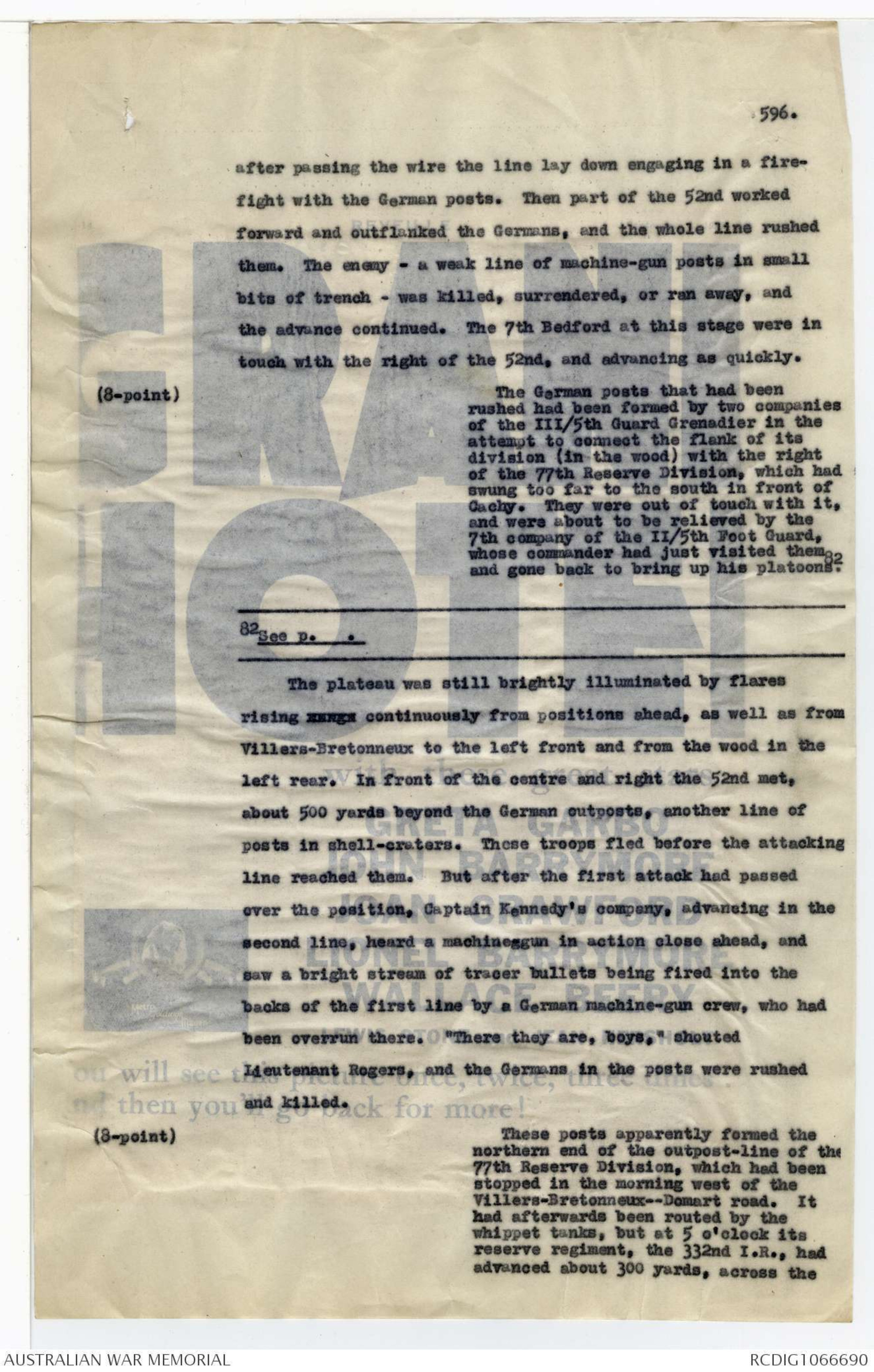
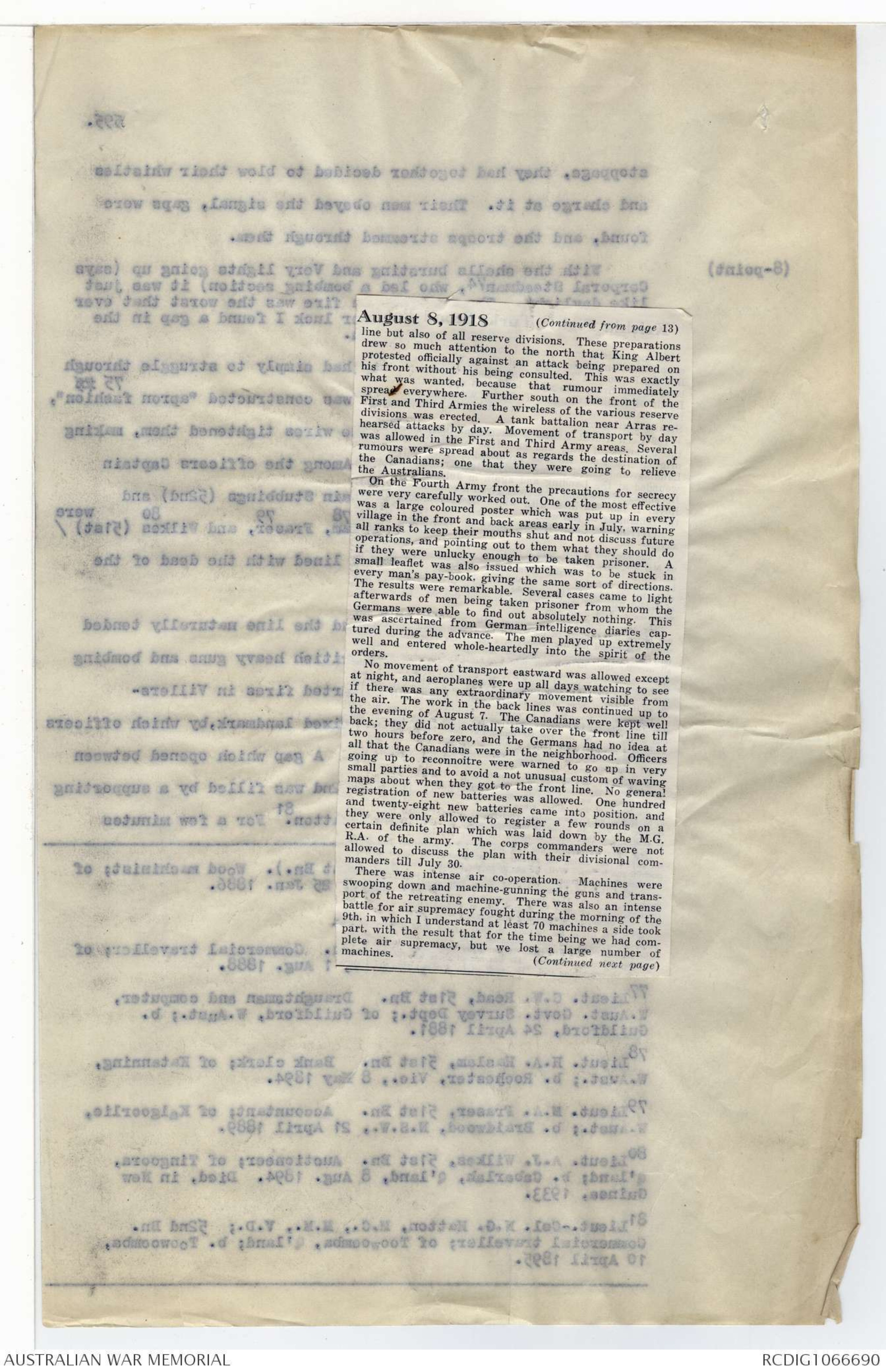
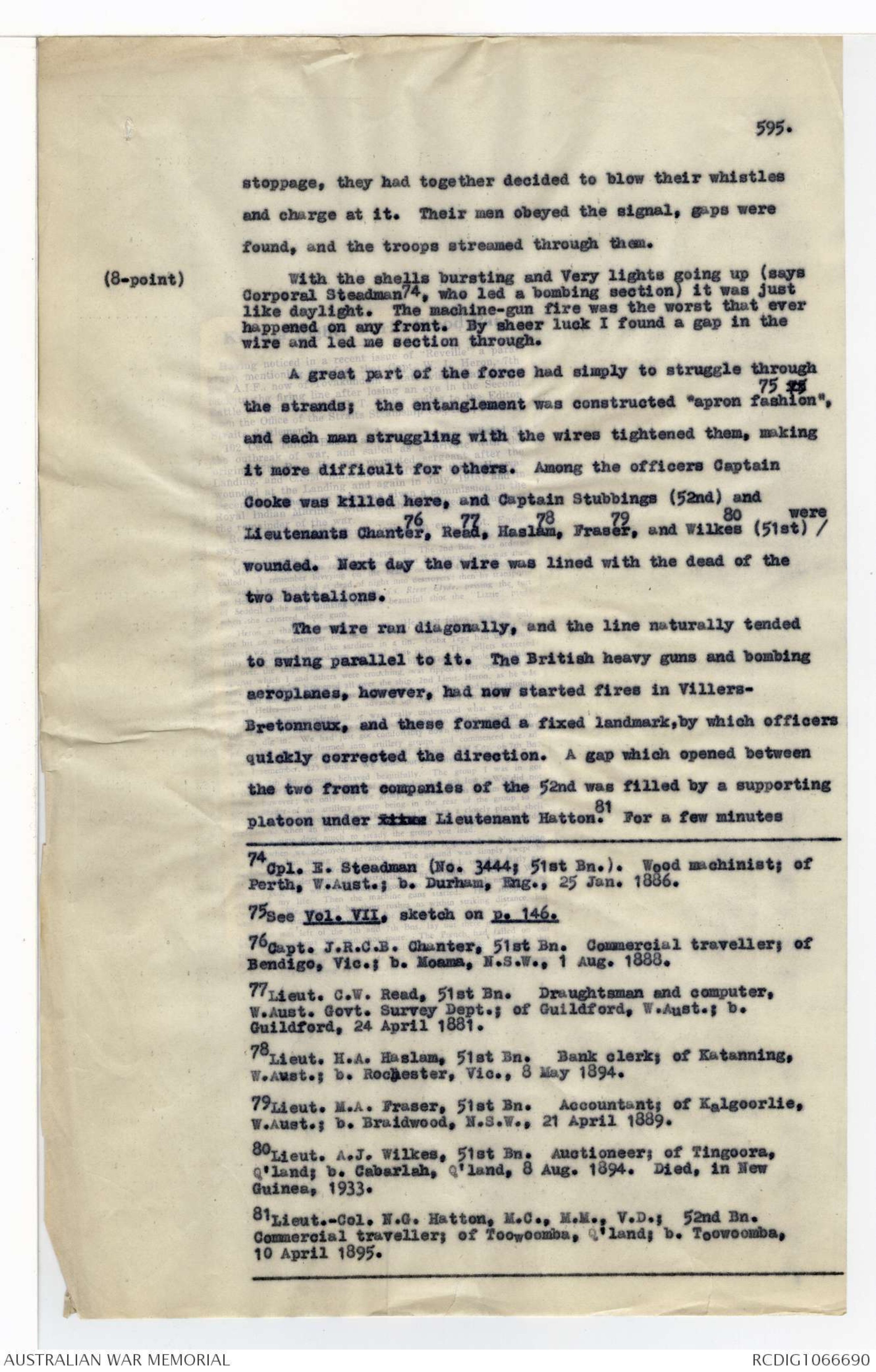



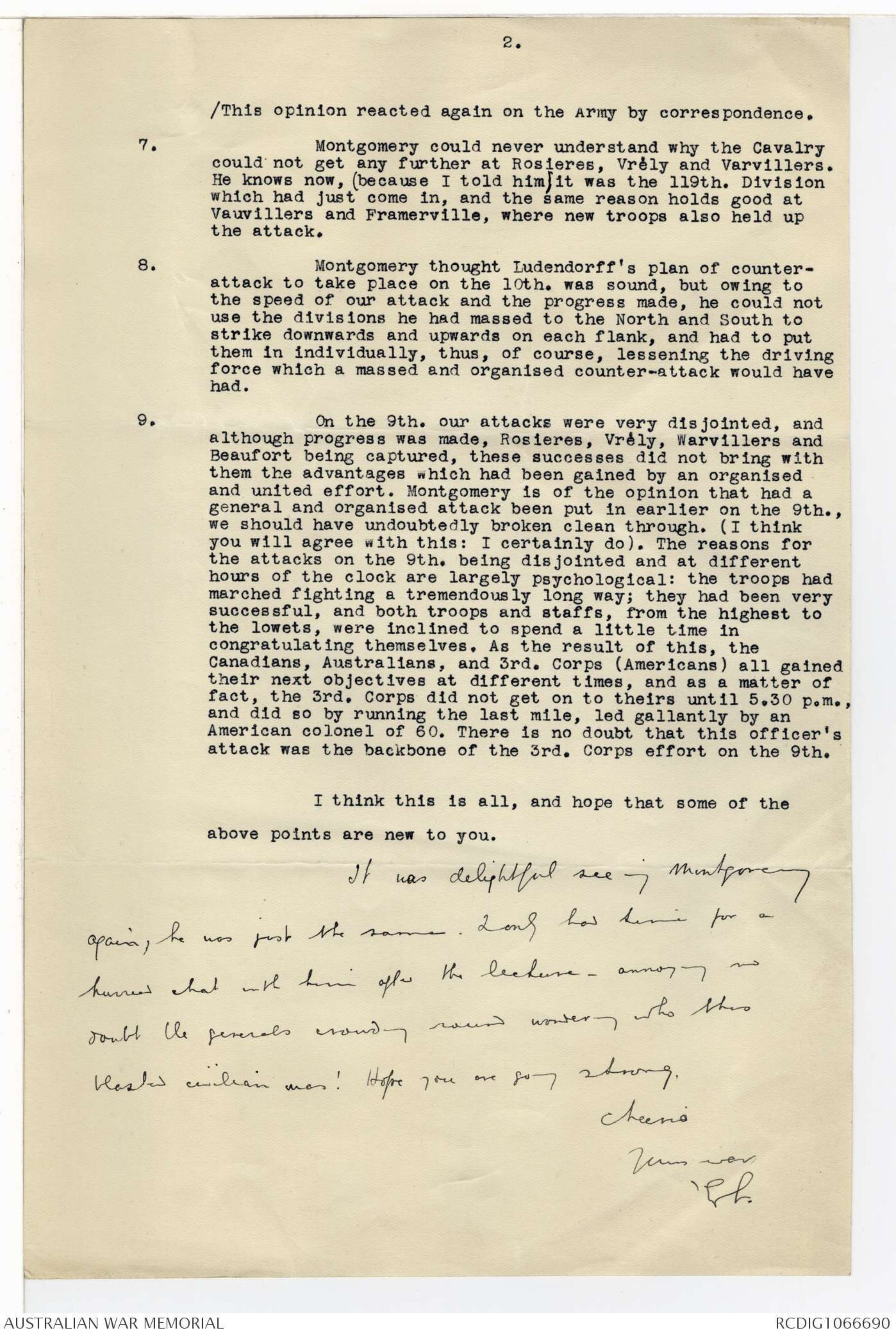
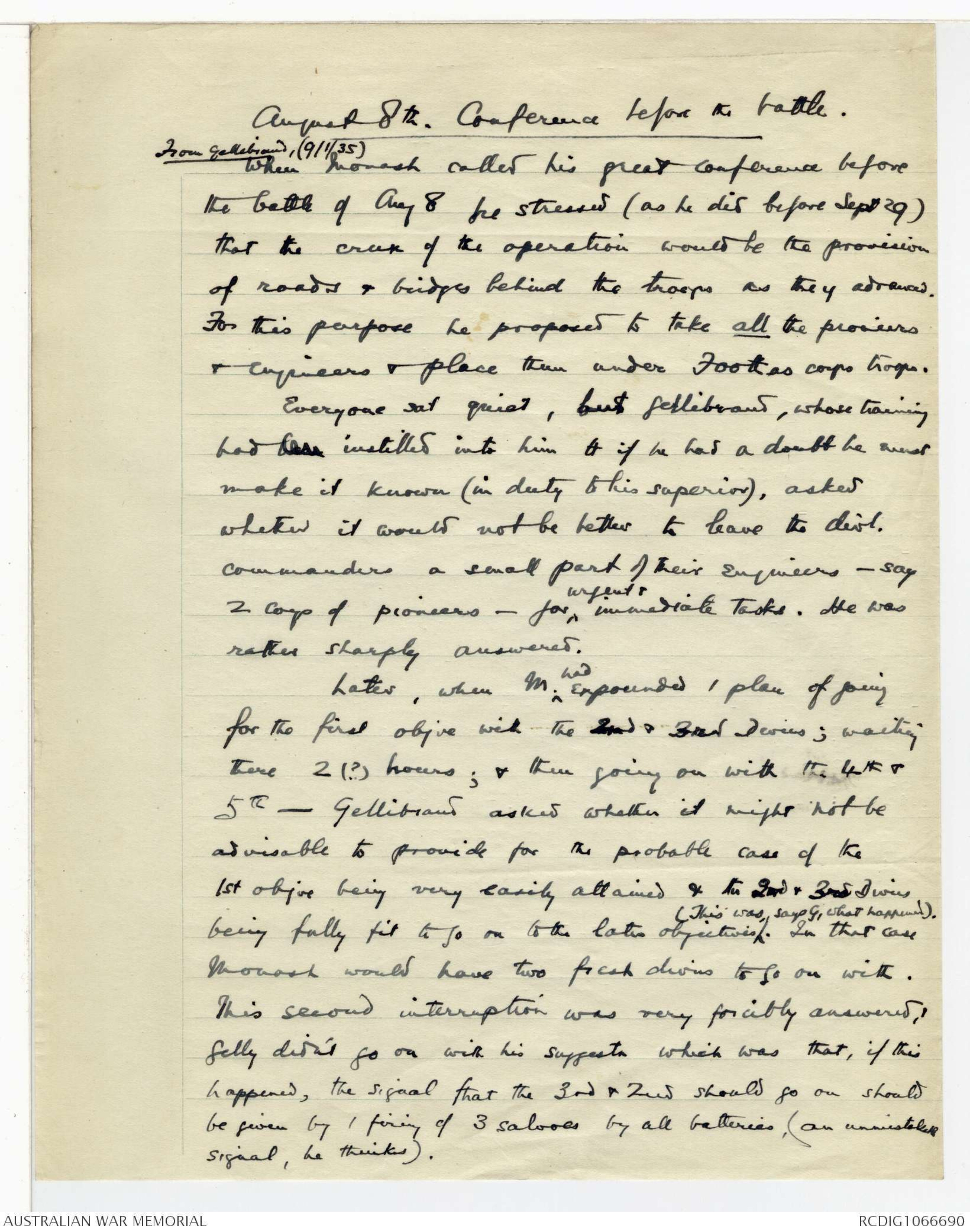
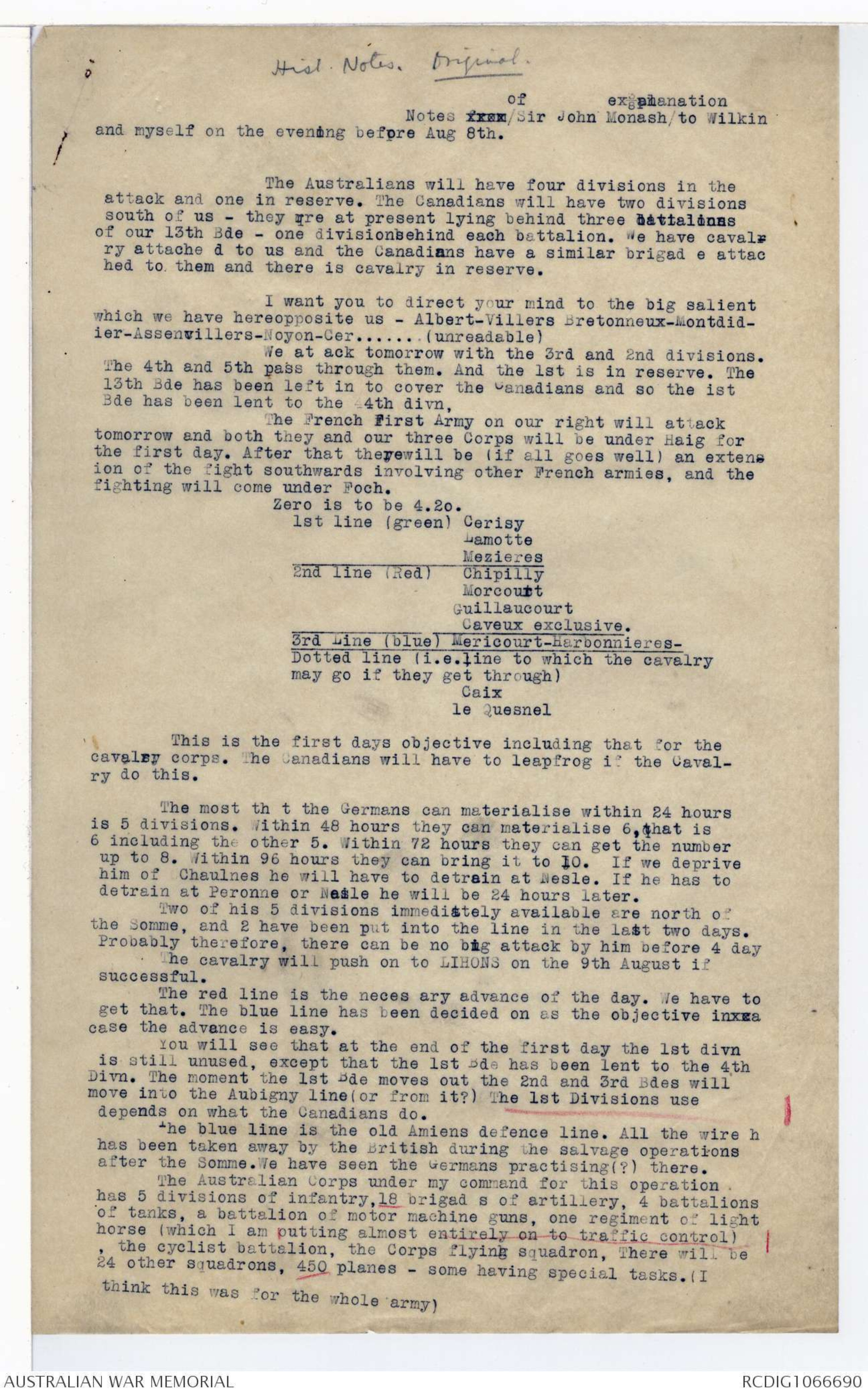
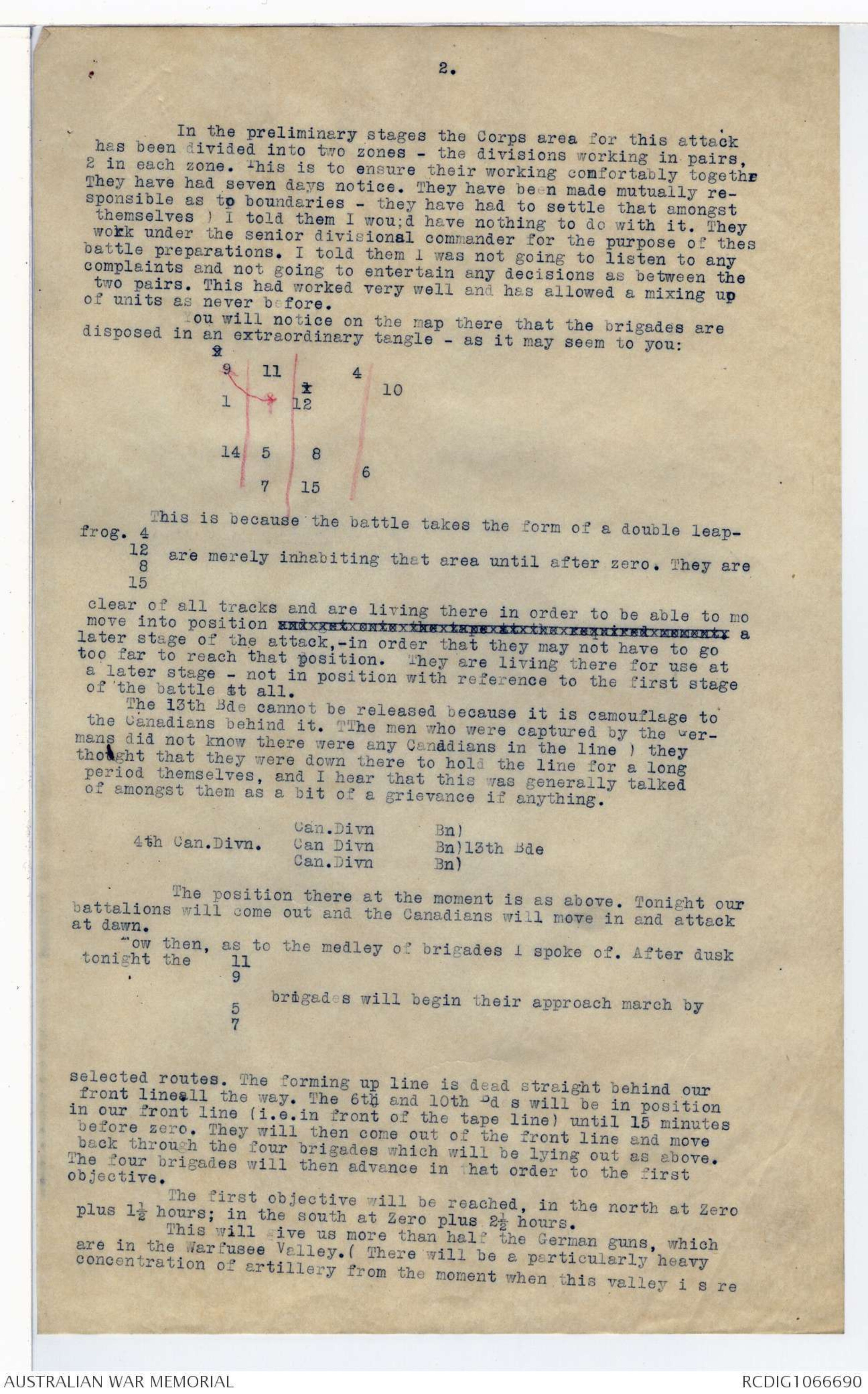
596.
after passing the wire the line lay down engaging in a fire-fight
with the Germans posts. Then part of the 52nd worked
forward and outflanked the Germans, and the whole line rushed
them. The enemy - a weak line of machine-gun posts in small
bits of trench - was killed, surrendered, or ran away, and
the advance continued. The 7th Bedford at this stage were in
touch with the right of the 52nd, and advancing as quickly.
(8-point)
The German posts that had been
rushed had been formed by two companies
of the III/5th Guard Grenadier in the
attempt to connect the flank of its
division (in the wood) with the right
of the 77th Reserve Division, which had
swung too far to the south in front of
Cachy. They were out of touch with it,
and were about to be relieved by the
7th company of the II/5th Foot Guard,
whose commander had just visited them
and gone back to bring up his platoons. 82
______________________________________________________________________________
82 See p. .
_________________________________________________________________
The plateau was still brightly illuminated by flares
rising xxxgx continuously from positions ahead, as well as from
Villers-Bretonneux to the left front and from the wood in the
left rear. In front of the centre and right the 52nd met,
about 500 yards beyond the German outposts, another line of
posts in shell-craters. These troops fled before the attacking
line reached them. But after the first attack had passed
over the position, Captain Kennedy's company, advancing in the
second line, heard a machineggun in action close ahead, and
saw a bright stream of tracer bullets being fired into the
backs of the first line by a German machine-gun crew, who had
been overrun there. "There they are, boys," shouted
Lieutenant Rogers, and the Germans in the posts were rushed
and killed.
(8-point) These posts apparently formed the
northern end of the outpost-line of the
77th Reserve Division, which had been
stopped in the morning west of the
Villers-Bretonneux--Domart road. It
had afterwards been routed by the
whippet tanks, but at 5 o'clock its
reserve regiment, the 332nd I.R., had
advanced about 300 yards, across the
August 8, 1918 (Continued from page 13)
line but also of all reserve divisions. These preparations
drew so much attention to the north that King Albert
protested officially against an attack being prepared on
his front without his being consulted. This was exactly
what was wanted, because that rumour immediately
spread everywhere. Further south on the front of the
First and Third Armies the wireless of the various reserve
divisions was erected. A tank battalion near Arras rehearsed
attacks by day. Movement of transport by day
was allowed in the First and Third Army areas. Several
rumours were spread about as regards the destination of
the Canadians; one that they were going to relieve
the Australians.
On the Fourth Army front the precautions for secrecy
were very carefully worked out. One of the most effective
was a large coloured poster which was put up in every
village in the front and back areas early in July, warning
all ranks to keep their mouths shut and not discuss future
operations, and pointing out to them what they should do
if they were unlucky enough to be taken prisoner. A
small leaflet was also issued which was to be stuck in
every man's pay-book, giving the same sort of directions.
The results were remarkable. Several cases came to light
afterwards of men being taken prisoner from whom the
Germans were able to find out absolutely nothing. This
was ascertained from German intelligence diaries captured
during the advance. The men played up extremely
well and entered whole-heartedly into the spirit of the
orders.
No movement of transport eastward was allowed except
at night, and aeroplanes were up all days watching to see
if there was any extraordinary movement visible from
the air. The work in the back lines was continued up to
the evening of August 7. The Canadians were kept well
back; they did not actually take over the front line till
two hours before zero, and the Germans had no idea at
all that the Canadians were in the neighborhood. Officers
going up to reconnoitre were warned to go up in very
small parties and to avoid a not unusual custom of waving
maps about when they got to the front line. No general
registration of new batteries was allowed. One hundred
and twenty-eight new batteries came into position, and
they were only allowed to register a few rounds on a
certain definite plan which was laid down by the M.G.
R.A. of the army. The corps commanders were not
allowed to discuss the plan with their divisional commanders
till July 30.
There was intense air co-operation. Machines were
swooping down and machine-gunning the guns and transport
of the retreating enemy. There was also an intense
battle for air supremacy fought during the morning of the
9th, in which I understand at least 70 machines a side took
part, with the result that for the time being we had complete
air supremacy, but we lost a large number of
machines. (Continued next page)
595.
stoppage, they had together decided to blow their whistles
and charge at it. Their men obeyed the signal, gaps were
found, and the troops streamed through them.
(8-point) With the shells bursting and Very lights going up (says
Corporal Steadman74, who led a bombing section) it was just
like daylight. The machine-gun fire was the worst that ever
happened on any front. By sheer luck I found a gap in the
wire and led me section through.
A great part of the forces had simply to struggle through
the strands, the entanglement was constructed "apron fashion",75 25
and each man struggling with the wires tightened them, making
it more difficult for others. Among the officers Captain
Cooke was killed here, and Captain Stubbings (52nd) and
Lieutenants Chanter76, Reed77, Haslam78, Fraser79, and Wilkes80, (51st) were
wounded. Next day the wire was lined with the dead of the
two battalions.
The wire ran diagonally, and the line naturally tended
to swing parallel to it. The British Army guns and bombing
aeroplanes, however, had now started fires in Villers-Bretonneux,
and these formed a fixed landmark, by which officers
quickly corrected the direction. A gap which opened between
the two front companies of the 52nd was filled by a supporting
platoon under Lietxx Lieutenant Hatton.81 For a few minutes
________________________________________________________________
74 Cpl. E. Steadman (No. 3444, 51st Bn.). Wood machinist; of
Perth, W.Aust., b. Durham, Eng., 25 June. 1886.
75 See Vol. III. sketch on p. 146.
76 Capt. J.R.C.B. Chanter, 51st Bn. Commercial traveller; of
Bendigo, Vic.; b. Moama, N.S.W., 1 Aug. 1888.
77 Lieut. C.W. Read, 51st Bn. Draughtsman and computer,
W.Aust., Govt. Survey Dept.; of Guildford, W.Aust.; b.
Guildford, 24 April 1881.
78 Lieut. H.A. Haslam, 51st Bn. Bank clerk; of Katanning,
W.Aust.; b. Rochester, Vic., 8 May 1894.
79 Lieut. M.A. Fraser, 51st Bn. Accountant; of Kalgoorlie,
W.Aust.; b. Braidwood, N.S.W., 21 April 1889.
80 Lieut. A.J. Wilkes, 51st Bn. Auctioneer; of Tingoora,
Q'land; b. Cabarlah, Q'land, 8 Aug. 1894. Died, in New
Guinea, 1933.
81Lieut-Col. N.G. Hatton, M.G., M.M., V.D.; 52nd Bn.
Commercial traveller; of Toowoomba, Q'land; b. Toowoomba,
10 April 1895.
_________________________________________________________________
Two disturbing events took place on August 3 and 6.
On August 3 a small Australian post of one sergeant and
four men was captured at Hourges, which is on the Roye
road east of the Luce. On August 6 the 18th Division
was attacked north of the Somme. It was a big attack,
and was meant for the Australians, who had never ceased
worrying, and the Germans sent down a special attacking
division, the 27th Wurtemberger, for the purpose.
Thirty-two mortars and 96 batteries supported this attack.
Unfortunately for the 18th Division, it hit them instead
of the Australians, and the Germans penetrated their line
to a depth of 800 yards. They took over 200 prisoners and
reached some of the artillery dumps. It was thought
that they must discover something, but such was not the
case. If the prisoners knew anything they gave nothing
away, and the Germans found out nothing at all. At
the time it was very disturbing.
It is not exaggeration to say that at zero on August 8
the battle was already won. The surprise was so complete,
the confidence of the troops was so great, and the forces
we had there so superior to the Germans in morale that
once the attack was started the result of the battle was
never in doubt. It was only a question of how far we
could go, and that was largely dependent on the endurance
of the troops.
On August 9 the British objectives were Roye, Chaulnes,
Bray, Dernancourt. This was a deep objective, but if
things were to go as well as they did on August 8 there
was no reason why we should not have advanced as far
as this. But a mistake was then made, and I am quite
certain that the first person to admit it would have been
Lord Rawlinson. Our attacks on the 8th were well concerted
and on a wide front. Our attacks on August 9 were
disjointed. The real reason for this was that the Canadian
Corps were allowed to fix the zero hour, whereas it
ought really to have been fixed by Army Headquarters.
What actually happened was that everyone was so busy
congratulating everyone else on their share in the victory
that valuable time was lost in preparing for an advance
next day. If the Army had fixed the zero hour and had
continued to press everyone to lose no time I can see
no reason now why the general advance should not have
been continued at 6 or 7 next morning.
As we know now, the probability is if this had been
done that the German resistance would have broken down
completely and we should have reached the Somme during
the 10th without much opposition. The lesson of this an
old one, and that is that once you have got your enemy
on the run you must press on with every available man
until exhaustion renders further pursuit impossible. The
reason why the Canadians were allowed to fix the zero
hour was that the main attack was to be made by them,
while the Australians advanced in echelon on their left.
The III. Corps was to make an attack north of the Somme
quite independent of the Canadian and Australian attack,
and it was known would not be ready to attack till the
afternoon.
What actually took place was as follows. The 4th
Canadian Division attacked Le Quesnel at 4 o'clock in the
morning and captured it. The 3rd Canadian Division then
went through the 4th at 12 o'clock, and reached Bouchoir
at 3.30 in the afternoon. On their left the 1st Canadians
commenced their advance at 1 p.m. They reached Warvillers
and Beaufort by 3.30 and Rouvroy at dusk. Next
to them the 2nd Canadians advanced at 11 a.m. with
both their flanks exposed for two hours or more. They
captured Rosieres and Vraly after some heavy fighting
with the 119th German Division, and with the aid of the
cavalry reached Meharicourt that evening. North of the
railway there was a delay in the arrival of the 1st Australian
Division, which was brought up from reserve.
The 5th Australians therefore made the initial attack
against Vauvillers, which they captured at 1 o'clock.
The 1st Australians passed through at 1.40 and attacked
towards Lihons. They were not able to advance further
than half-way up the Lihons Hill. Further north the 2nd
Australians did not capture Framerville till half-past four.
North of the Somme the III. Corps did not attack till
5.30. Owing to the German resistance on the previous
day there was a good deal of confusion, and it was necessary
to give time for an American regiment, the 131st,
of the 33rd American Division, to be brought up. This
regiment had to double for the last five minutes to enable
it to arrive on the starting line in time for zero, and it
then advanced, headed by its gallant colonel. This
American regiment was largely instrumental in the capture
of the Chipilly Spur and the success gained by the
III. Corps on August 9. It was supported by the 58th
and 12th Divisions. I have no doubt that lives could have
been saved and a more satisfactory advance made on
the 9th if the attacks of the various divisions had been
properly co-ordinated; but even as it was a large further
advance had been made, and many more prisoners and
guns captured.
594.
minutes.....The bullets were still thick. I leant forward
and put my hand on the boy's shoulder...He said he wasn't hit
but was just done up. "Well," I said, "we are all going up
in a minute with one of these shells. You are just as safe
with the boys." He nodded and said he believed I was right,
and went after them. He was the only boy I saw hesitate thatnightxxxxxx night......A little Tommy corporal came stumbling
in, weeping like a kid and holding his arm. "Pain bad," says
I. "No, Sir," he squeaked, "this is nothing, but I can't get
the boys to go forward." He had evidently been trying to
rally a very young platoon with a bullet in his arm. A
wounded digger soothed him, "Never mind, kid," he said, "the
boys will hunt Fritz without yous kids."
Some distance ahead of the Cachy Switch was the strong
diagonal line of wire originally constructed for it, and, as
this was approached, the fire became close and deadly. It
was evident that the Germans attacking that morning had
established their outpost-line on the other side of the wire.
Five or six machine-guns were firing through it, and others
from distant positions in the south-east; but most deadly by
far was a gun away to the left flank where the wire, running
towards Villers-Bretonneux, dipped into the hollow south of
the town, and a single German machine-gunner was firing from
one of the sunken roads that crossed there, directly along
the Cachy road and the wire. The Australians nearest to him
were the remnant of Sadlier's platoon, now under Sergeant
Dagnall.72 The line was temporarily stopped. The Australians
near by tried first to get round the open on the right of the
gun; next round the open on its left. Eventually Sergeant
(TAKEN IN SKETCH No. 178)
Stokes, in his skillful assault upon gun after gun, silenced
and captured this the one also.
It had caused dreadful loss along the entanglement; but
long before it was stopped the battalions had passed that
obstacle. Captain Harburn had found Captain Cooke73 of the
______________________________________________________________
72 Sgt. T.N. Dagnall (No. 2529; 51st Bn.). Station hand; of
Geraldton, W.Aust.; b. Liverpool, Eng., 25 Dec. 1889.
73Capt. C.E.A. Cooke, 51st Bn. Electrician; of Boulder,
W.Aust.; b. North Fitzroy, Vic., 29 July 1891. Killed in
action, 24 April 1918.
______________________________________________________________
right company of the 51st, and, to prevent a permanent
H.N. for Copying
Coblenz,
19th. March, 1925.
My dear Bean,
Iwas in Cologne on Friday and Saturday on business,
and was fortunate enough to find my visit coincided with
a lecture given by Major General Sir Archibald Montgomery,
(Rawly's M.G.G.S.), on the Big rush on the 8th. August. The
lecture was a most interesting one, and possibly contained
points which are not in the "Battle of 100 days", and which
may be new and of use to you. Here are those which struck me
as being most interesting:
1. One of the chief reasons which gave Rawlinson the
idea of an offensive on this front was the tremendous moral
superiority which had been gained by the Australians over the
Germans.
2. Rawlinson's original idea was for the British Army
to push East from Dernancourt down to about Domart, and for
the French to strike upwards towards Montdidier. Foch was
against this, and Rawlinson was overruled, though
Montgomery says he cannot remember that Foch produced any
really decent arguments.
3. Rawlinson learned much from/(a) the German Spring
Offensive; (b) Hamel; (c) Mangin's counter-attack at Villers
Cotteret. From (a) he learned that reserves should start
moving at the same time as the troops in front hop the bags,
the whole offensive thus moving at zero; (b), everything went
like clockwork at Hamel, and the 8th. August show was all
arranged on Hamel lines, Hamel being regarded as a miniature
model attack; from (c) he learned that SURPRISE was
everything.
4. Montgomery thought that Monash was a little unfair
to the 3rd. Corps. They were badly knocked about on the 6th.
August, the new Brigade brought in having never seen the
ground; their cadres had been filled up largely with boys,
and there was a great lack of experienced officers. The
ground was undoubtedly very difficult and unsuitable for
tanks, and they started the attack without the tanks, which
were an hour late. The great anxiety all over the front was
Gas, (This was why Abbey Wood was left absolutely empty, as
it was the Germans' favourite gassing ground), and the 3rd
Corps was the only one prior to the attack which got a dose.
These are Montgomery's excuses for the 3rd. Corps.
5. In Montgomery's opinion the success of the whole
battle was due to three things: Superior morale; Surprise;
and Good Organisation.
6. German superiority in numbers on the 8th. August
was pretty much the same as on the 21st. March, but there was
a tremendous difference in morale. Mangin's attack,
especially, had caused great depression, not only in the
German Army, but also in Germany itself, the people not
understanding that if German troops were winning, how the
Allies could put up a successful counter-attack. This
2.
/This opinion reacted again on the Army by correspondence.
Montgomery could never understand why the Cavalry
could not get any further at Rosieres, Vrély and Varvillers.
He knows now, (because I told him) it was the 119th. Division
which had just come in, and the same reason holds good at
Vauvillers and Framerville, where new troops also held up
the attack.
Montgomery thought Ludendorff's plan of counter-attack
to take place on the 10th. was sound, but owing to
the speed of our attack and the progress made, he could not
use the divisions he had massed to the North and South to
strike downwards and upwards on each flank, and had to put
them in individually, thus, of course, lessening the driving
force which a massed and organised counter-attack would have
had.
On the 9th. our attacks were very disjointed, and
although progress was made, Rosieres, Vrély, Warvillers and
Beaufort being captured, these successes did not bring with
them the advantages which had been gained by an organised
and united effort. Montgomery is of the opinion that had a
general and organised attack been put it earlier on the 9th.,
we should have undoubtedly broken clean through. (I think
you will agree with this: I certainly do). The reasons for
the attacks on the 9th. being disjointed and at different
hours of the clock are largely psychological: the troops had
marched fighting a tremendously long way; they had been very
successful, and both troops and staffs, from the highest to
the lowets, were inclined to spend a little time in
congratulating themselves. As the result of this, the
Canadians, Australians, and 3rd. Corps (Americans) all gained
their next objectives at different times, and as a matter of
fact, the 3rd. Corps did not get on to theirs until 5.30 p.m.,
and did so by running the last mile, led gallantly by an
American colonel of 60. There is no doubt that this officer's
attack was the backbone of the 3rd. Corps effort on the 9th.
I think this is all, and hope that some of the
above points are new to you.
It was delightful seeing Montgomery
again, he was just the same. I only had time for a
hurried chat with him after the lecture - annoying no
doubt the generals crowding round wondering who this
blasted civilian was! Hope you are going strong.
Cheers
Yours ever
[['EL.?]]
August 8th. Conference before the battle.
from Gellibrand (9/1/35)
When Monash called his great conference before
the battle of Aug 8 he stressed (as he did before Sept 29)
that the crux of the operation would be the provision
of roads & bridges behind the troops as they advanced.
For this purpose he proposed to take all the pioneers
& engineers & place them under Foott as corps troops.
Everyone sat quiet, but Gellibrand, whose training
had been instilled into him tt if he had a doubt he must
make it known (in duty to his superior), asked
whether it would not be better to leave divl.
Commanders a small part of their engineers - say
2 Coys of pioneers - for ^urgent & immediate tasks. He was
rather sharply answered.
Later, when M. ^had expounded / plan of going
for the final objve with the 2nd & 3rd Divns; waiting
there 2(?) hours; & then going on with the 4th &
5th - Gellibrand asked whether it might not be
advisable to provide for the probable case of the
first objve being very easily attained & the 2nd & 3rd Divns
being fully fit to go on to the later objectives ^(This was, says G, what happened). In that case
Monash would have two fresh divns to go on with.
The second interruption was very forcibly answered,
Gelly didn't go on with his suggestn which was that, if this
happened, the signal that the 3rd & 2nd should go on should
be given by / firing of 3 salvoes by all batteries (an unmistakable
signal, he thinks).
Hist. Notes. Original.
Notes from of Sir John Monash explanation to Wilkin
and myself on the evening before Aug 8th.
The Australians will have four divisions in the
attack and one in reserve. The Canadians will have two divisions
south of us - they are at present lying behind three battalions
of our 13th Bde - one divisionbehind each battalion. We have cavalry
attache d to us and the Canadians have a similar brigad e attached
to them and there is cavalry in reserve.
I want to direct your mind to the big salient
which we have hereopposite us - Albert-Villers Bretonneux-Montdidier-Assenvillers-Noyon-Cer.......(unreadable)
We at ack tomorrow with the 3rd and 2nd divisions.
The 4th and 5th pass through them. And the 1st is in reserve. The
13th Bde has been left in to cover the Canadians and so the 1st
Bde has been lent to the 4th divn.
The French First Army on our right will attack
tomorrow and both they and our three Corps will be under Haig for
the first day. After that therewill be (if all goes well) an extension
of the fight southwards involving other French armies, and the
fighting will come under Foch.
Zero is to be 4.20
1st line (green) Cerisy
Lamotte
Mezieres
————————————————
2nd line (Red) Chipilly
Morcourt
Guillaucourt
Caveux exclusive.
————————————————
3rd line (white) Mericourt-Harbonnieres-
————————————————
Dotted line (i.e. line to which the cavalry
may go through if they get through)
Caix
le Quesnel
This is the first days objective including that for the
cavalry corps. The Canadians will have to leapfrog if the Cavalry
do this.
The most th t the Germans can materialise within 24 hours
is 5 divisions. Within 48 hours they can materialise 6,that is
6 including the other 5. Within 72 hours they can get the number
up to 8. Within 96 hours they can bring it to 10. If we deprive
him of Chaulnes he will have to detrain at Nesle. If he has to
detrain at Peronne or Nesle he will be 24 hours later.
Two of his 5 divisions immediately available are north of
the Somme, and 2 have been put into the line in the last two days.
Probably therefore, there can be no big attack by him before 4 day
The cavalry will push on to LIHONS on the 9th August if
successful.
The red line is the neces ary advance of the day. We have to
get that. The blue line has been decided on as the objective inxxa
case the advance is easy.
You will see that at the end of the first day the 1st divn
is still unused, except that the 1st Bde has been lent to the 4th
Divn. The moment the 1st Bde moves out the 2nd and 3rd Bdes will
move into the Aubigny line (or from it?) The 1st Divisions use
depends on what the Canadians do.
The blue line is the old Amiens line. All the wire h
has been taken away by the British during the salvage operations
after the Somme.We have seen the Germans practising (?) there.
The Australian Corps under my command for this operation
has 5 divisions of infantry, 18 brigad s of artillery, 4 battalions
of tanks, a battalion of motor machine guns, one regiment of light
horse (which I am putting almost entirely onto traffic control)
, the cyclist battalion, the Corps flying squadron. There will be
24 squadrons, 450 planes - some having special tasks. (I
think this was for the whole army)
2.
In the preliminary stages the Corps area for this attack
has been divided into two zones - the divisions working in pairs,
2 in each zone. This is to ensure their working comfortably togethr
They have had seven days notice. They have been made mutually
responsible as to boundaries - they have had to settle that amongst
themselves I told them I wou;d have nothing to do with it. They
work under the senior divisional commander for the purpose of thes
battle preparations. I told them I was not going to listen to any
complaints and not going to entertain any decisions as between the
two pairs. This had worked very well and has not allowed a mixing up
of units as never before.
You will notice on the map there that the brigades are
disposed in an extraordinary tangle - as it may seem to you:
Sketch - see original document
This is because the battle takes the form of a double leapfrog.
4
12 are merely inhabiting that area until after zero. They are
8
15
clear of all tracks and are living there in order to be able to mo
move into position and get onto the tape at the required moment. a
later stage of the attack, -in order that they may not have to go
too far to reach that position. They are living there for use at
a later stage - not in position with reference to the first stage
of the battle at all.
The 13th Bde cannot be released because it is camouflage to
the Canadians behind it. TThe men who were captured by the Germans
did not know there were any Canadians in the line ) they
thought that they were down there to hold the line for a long
period themselves, and I hear that this was generally talked
of amongst them as a bit of a grievance if anything.
Can.Divn Bn)
4th Can.Divn Can.Divn Bn)13th Bde
Can.Divn Bn)
The position there at the moment is as above. Tonight our
battalions will come out and the Canadians will move in and attack
at dawn.
Now then, as to the medley of brigades I spoke of. After dusk
tonight the 11
9
brigades will begin their approach march by
5
7
selected routes. The forming up line is dead straight behind our
front lineall the way. The 6th and 10th Bd s will be in position
in our front line (i.e. in front of the tape line) until 15 minutes
before zero. They will then come out of the front line and move
back through the four brigades which will be lying out as above.
The four brigades will then advance in that order to the first
objective.
The first objective will be reached, in the north at Zero
plus 1½ hours; in the south at Zero plus 2½ hours.
This will give us more than half the German guns, which
are in the Warfusee Valley. (There will be a particularly heavy
concentration of artillery from the moment when this valley i s re
 Sam scott
Sam scottThis transcription item is now locked to you for editing. To release the lock either Save your changes or Cancel.
This lock will be automatically released after 60 minutes of inactivity.